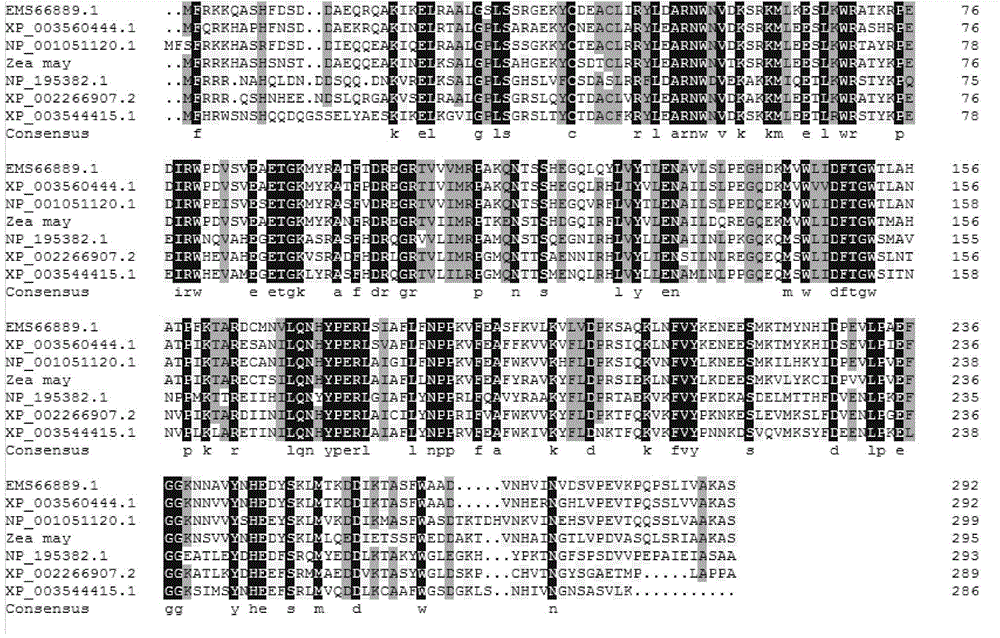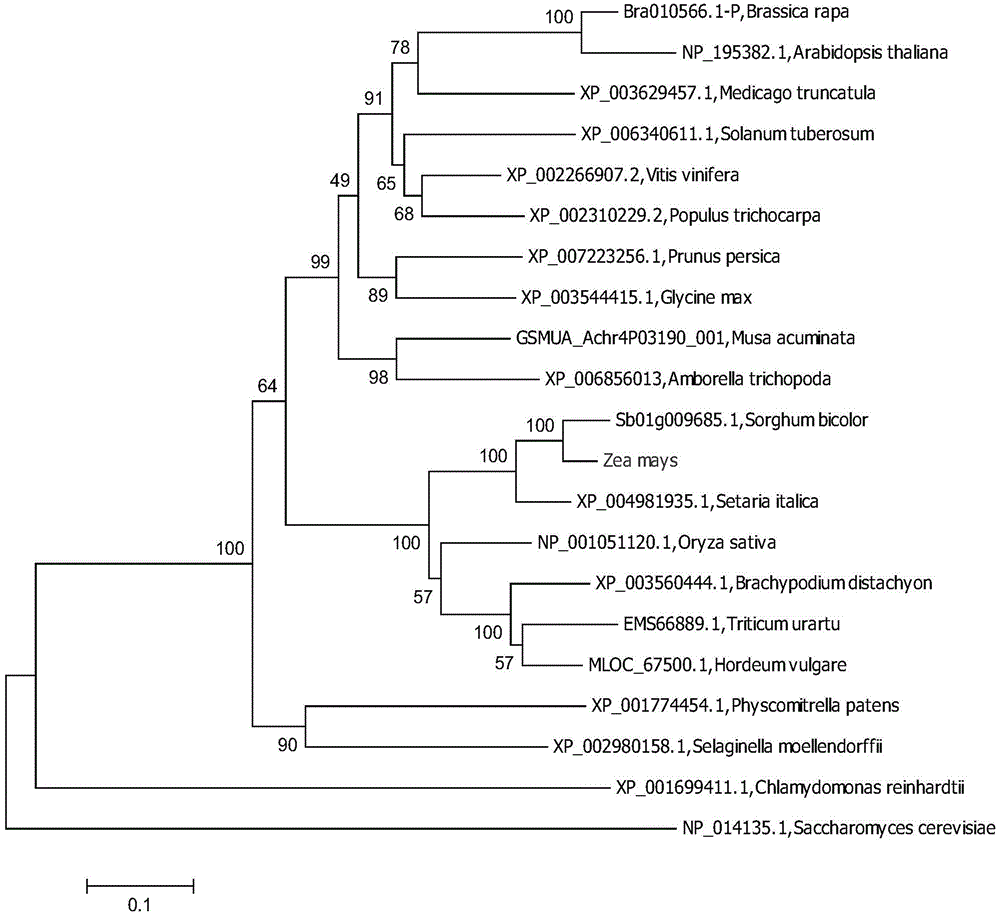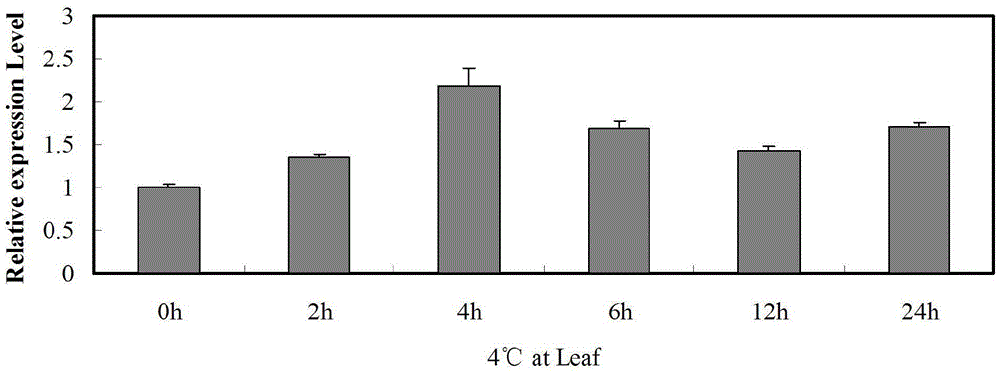Clone of corn phosphatidylinositol transportprotein gene ZmSEC14p and application thereof
A technology of phosphatidylinositol and transporter, applied in the field of molecular biology and biology, to achieve the effect of improving cold resistance
- Summary
- Abstract
- Description
- Claims
- Application Information
AI Technical Summary
Problems solved by technology
Method used
Image
Examples
Embodiment 1
[0048] Example 1: Cloning of maize phosphatidylinositol transporter gene ZmSEC14
[0049] 1. Extraction of RNA
[0050] Total RNA was extracted from maize leaves using RNAiso Reagent (Takara, Japan) kit.
[0051] (1) When the corn grows to the three-leaf stage, put it in an artificial climate box, treat it at low temperature (4°C) for 12 hours, take 3 leaves of the same part (the young part of the third leaf) and mix (about 40mg) Put it into a 1.5mL centrifuge tube, quickly add liquid nitrogen to freeze and grind it into powder.
[0052] (2) Quickly add 1mL RNAiso reagent (Takara) reagent to the tube, and let stand at room temperature for 5 minutes until the powder melts, flick the tube wall to spread the powder evenly in the reagent, let stand at room temperature for 10 minutes.
[0053] (3) 12,000×g, 4°C, centrifuge for 15 minutes.
[0054] (4) Aspirate the supernatant, add 0.2ml chloroform, shake vigorously, and let stand at room temperature for 5 minutes.
[0055] (5) ...
Embodiment 2
[0098] Example 2: Bioinformatics analysis of maize ZmSEC14 gene
[0099] The ZmSEC14p gene encodes a maize phosphatidylinositol transporter, its open reading frame has 888 bp nucleotides, encodes 295 amino acids, and has a protein size of 33.978 KD. Using the NCBI website to analyze the functional domains of the ZmSEC14 protein, it was found that the protein contained a conserved SEC14 domain (86-241aa) and a CRAL-TRIO-N domain (19-65aa). Using DNAMAN software to perform multiple comparisons of the SEC14p amino acid sequences of various plants (rice, barley, soybean, Arabidopsis, millet, sorghum, wheat, grape) (such as figure 1 shown), the results showed that these genes had high homology in the conserved SEC14 domain. Therefore, this gene belongs to one of the members of the SEC14 superfamily.
[0100] The NCBI database combined with the maizegdb database searched for homologous SEC14 amino acid sequences in different species, including: rice (NP_001051120.1), barley (MLOC_...
Embodiment 3
[0101] Example 3: Response of maize ZmSEC14p gene to abiotic stress
[0102] When the corn grows to the three-leaf and one-heart stage, it is treated with low temperature (4°C), Nacl (250mM), and ABA (100uM) for 0h, 2h, 4h, 6h, 12h, and 24h, respectively. RNA was extracted from maize leaves and roots for analysis of relative gene expression. ABI7500RealTime PCR System (Applied Biosystems) and 7500System software version 1.3.1 were used for Real-time RT-PCR amplification. RNA extraction and cDNA first-strand synthesis were the same as above. Afterwards, the cDNA was diluted 5 times, and Real-time PCR was performed according to the instructions of the kit SYBR Green RealMasterMix with ROX. The primers used are as follows:
[0103] YGSEC14F: 5'-AAAATCTGCACTTGGTCCTT-3'
[0104] YGSEC14R: 5'-GTCCATCCCGTGAAGTCTAT-3'
[0105] ActinF: 5'-CGATTGAGCATGGCATTGTCA-3'
[0106] ActinR:5'-CCCACTAGCGTACAACGAA-3'
[0107] GAPDHF; 5'-CCCTTCATCACCACGGACTAC-3'
[0108] GAPDHR; 5'-ACCTTCTTG...
PUM
 Login to View More
Login to View More Abstract
Description
Claims
Application Information
 Login to View More
Login to View More - R&D
- Intellectual Property
- Life Sciences
- Materials
- Tech Scout
- Unparalleled Data Quality
- Higher Quality Content
- 60% Fewer Hallucinations
Browse by: Latest US Patents, China's latest patents, Technical Efficacy Thesaurus, Application Domain, Technology Topic, Popular Technical Reports.
© 2025 PatSnap. All rights reserved.Legal|Privacy policy|Modern Slavery Act Transparency Statement|Sitemap|About US| Contact US: help@patsnap.com



